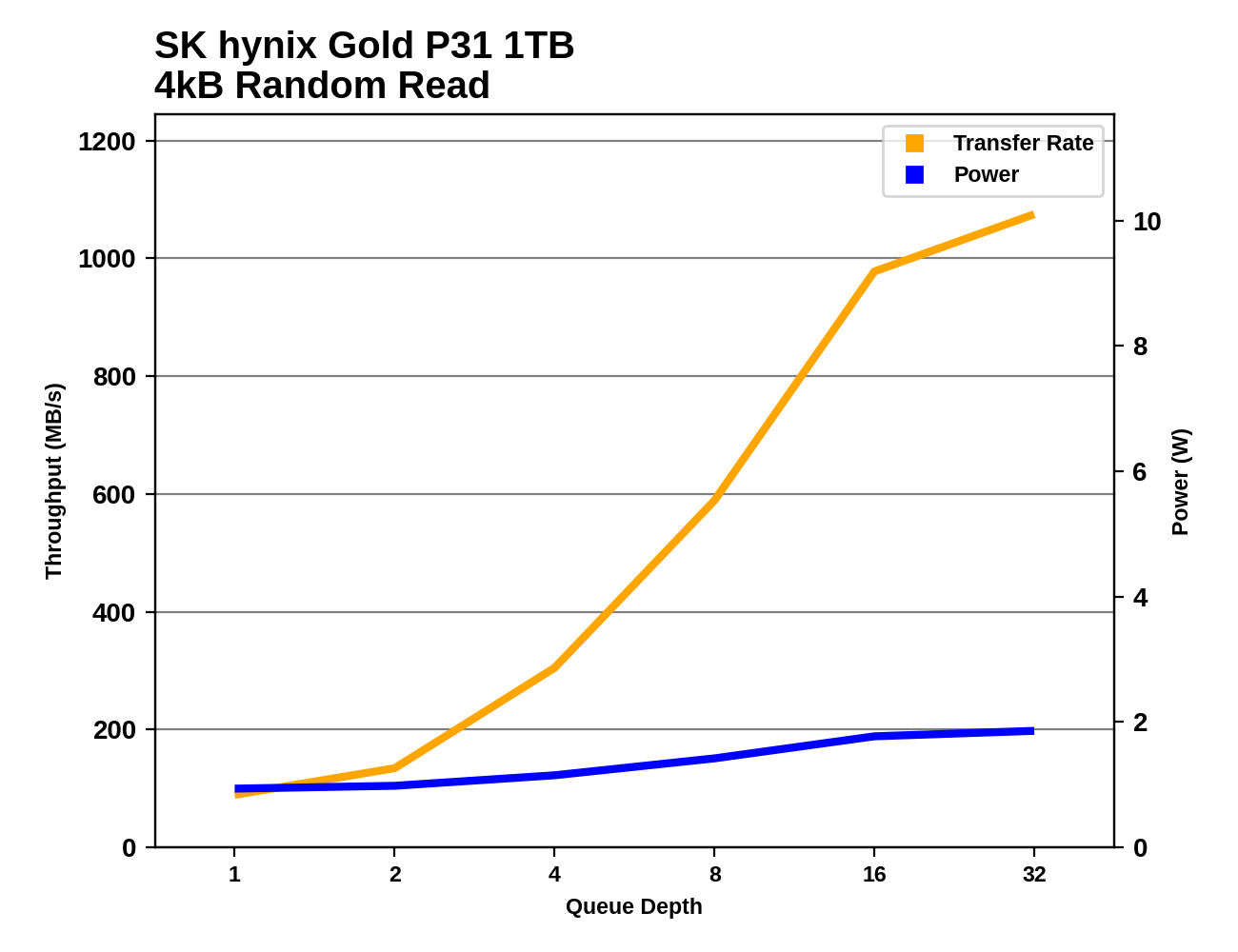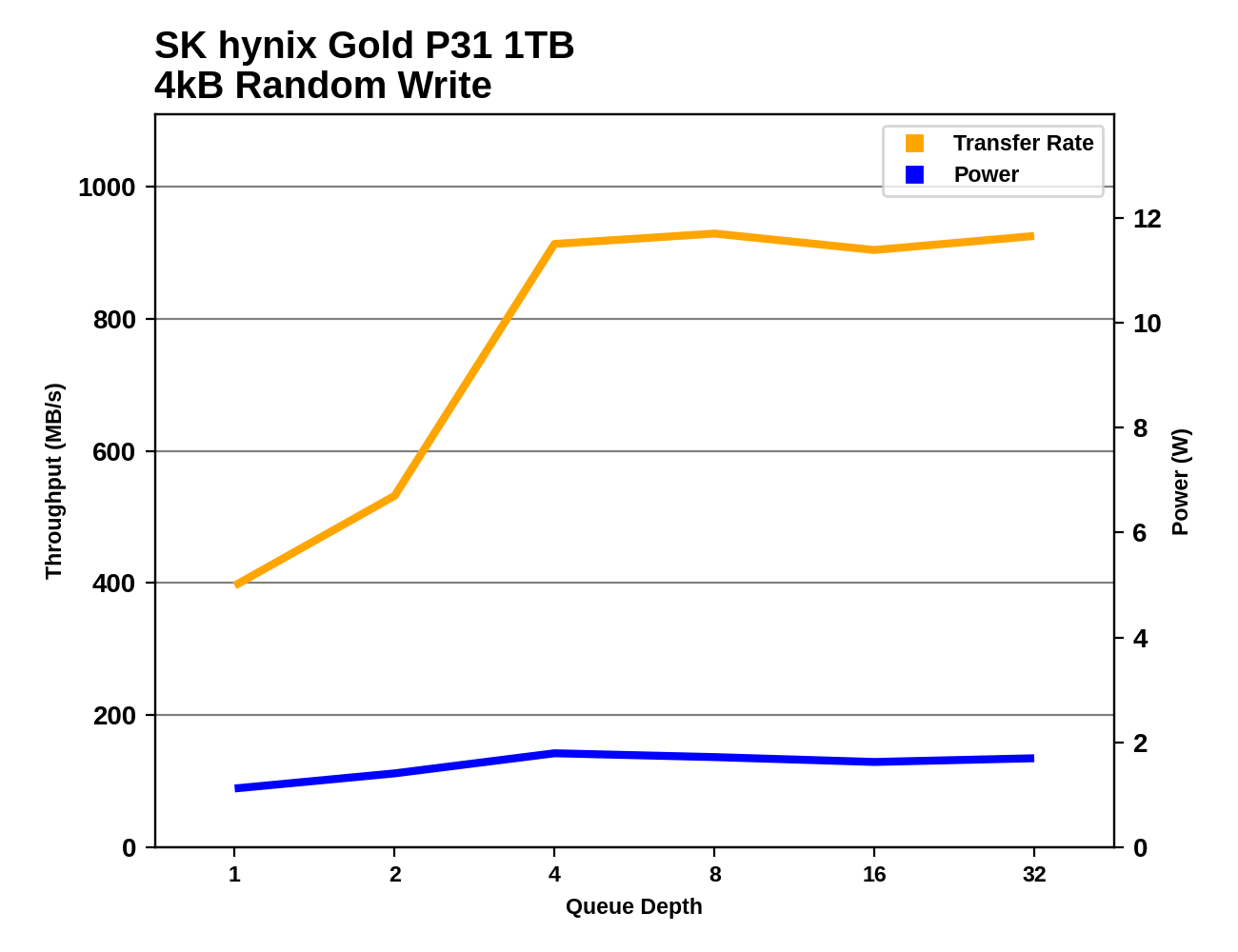The Best NVMe SSD for Laptops and Notebooks: SK hynix Gold P31 1TB SSD Reviewed
by Billy Tallis on August 27, 2020 8:00 AM ESTRandom Read Performance
Our first test of random read performance uses very short bursts of operations issued one at a time with no queuing. The drives are given enough idle time between bursts to yield an overall duty cycle of 20%, so thermal throttling is impossible. Each burst consists of a total of 32MB of 4kB random reads, from a 16GB span of the disk. The total data read is 1GB.

The QD1 burst random read performance of the SK hynix Gold P31 is similar to what we see from drives using the Silicon Motion SM2262EN controller, which has dominated this test since it hit the market.
Our sustained random read performance is similar to the random read test from our 2015 test suite: queue depths from 1 to 32 are tested, and the average performance and power efficiency across QD1, QD2 and QD4 are reported as the primary scores. Each queue depth is tested for one minute or 32GB of data transferred, whichever is shorter. After each queue depth is tested, the drive is given up to one minute to cool off so that the higher queue depths are unlikely to be affected by accumulated heat build-up. The individual read operations are again 4kB, and cover a 64GB span of the drive.

On the longer random read test that reaches into higher queue depths, the Gold P31 pulls narrowly ahead of the SX8200 Pro to set a new record for TLC-based SSDs.
 |
|||||||||
| Power Efficiency in MB/s/W | Average Power in W | ||||||||
The power draw of the Gold P31 is only a hair above that of its SATA sibling, the Gold S31. But the P31 is delivering almost three times the performance of that drive, and twice the performance per Watt of the next most efficient drive.
 |
|||||||||
The Gold P31 delivers class-leading performance across the entire range of queue depths covered by this test. Its performance is starting to taper off by QD32, but at that point it has caught up with the throughput of the Optane 905P. The widest margins over other TLC SSDs are around QD8 through QD16. Power consumption remains very low throughout the test, not even reaching 2W at QD32 - that 2x efficiency advantage over the competition remains just as true at high queue depths.
Plotting the P31's results against the entire benchmark database shows that the P31 stakes out new territory. The closest competition on the power/performance landscape are the tiny Intel Optane Memory M.2 drives, and at QD4 or higher all the other flash-based SSDs need considerably more power to deliver the same performance (at QD4 and below, the P31 is still in SATA performance territory where there are more low-power competitors).
Random Write Performance
Our test of random write burst performance is structured similarly to the random read burst test, but each burst is only 4MB and the total test length is 128MB. The 4kB random write operations are distributed over a 16GB span of the drive, and the operations are issued one at a time with no queuing.

The burst random write performance of the Gold P31 is lackluster: slower than most high-end NVMe drives, though actually still a bit faster than the Samsung 970 EVO Plus.
As with the sustained random read test, our sustained 4kB random write test runs for up to one minute or 32GB per queue depth, covering a 64GB span of the drive and giving the drive up to 1 minute of idle time between queue depths to allow for write caches to be flushed and for the drive to cool down.

On the longer random write test that includes some higher queue depths, the high-end NVMe drives mostly have fairly similar scores, and the P31 falls in the middle of the pack for performance.
 |
|||||||||
| Power Efficiency in MB/s/W | Average Power in W | ||||||||
Once again, the power consumption of the Gold P31 is more in line with low-power SATA or DRAMless NVMe drives, even though it offers high-end performance. This time, the efficiency score isn't quite twice that of the next best competitor, but a 75% improvement is still impressive.
 |
|||||||||
The performance profile for the Gold P31 on the random write test is fairly typical: fill performance is reached at QD4, and performance is mostly steady through the rest of the test. The P31 starts out slightly slower at QD1, but at full speed it is definitely competitive.
Comparing the Gold P31's random write performance against our entire database of results shows it standing out even more clearly than it did for the random read results. The QD1 random write performance is already beyond the reach of SATA drives, and none of the other NVMe drives we've tested operate at such low power levels.












80 Comments
View All Comments
jaydee - Tuesday, September 1, 2020 - link
Thanks Billy! Reading the part about the power efficiency though, any thoughts of quantifying the extra battery life you could expect to see (typical laptop) from the SK Hynix Gold P31 over a Phison E12? The numbers look impressive on paper in terms of percentages against other HDs, but what are we talking about? An extra.. 5/10/15/20 minutes under an extreme R/W heavy workload? What about an average R/W workload? For sure the price/performance is there too so it appears a good buy anyway, I just don't know what to make of the efficiency numbers in terms of actual computing experience.Jimster480 - Saturday, September 5, 2020 - link
I just put this into my new Ryzen 4600H Powered Nitro 5 and it beats my EX920 in everything! Really a leap in performance and power consumption that wasn't expected from SK Hynix that has been an Also-ran until now!rlr297 - Wednesday, September 23, 2020 - link
Is there an update on when the platinum drives will be released? I am looking for a 2TB variant. If not, do you have a 2TB drive you'd recommend for a laptop?MatthiasM - Tuesday, November 10, 2020 - link
Hi All: Can I please ask for collective wisdom? I was very impressed by the review of this drive, especially the low power consumption for laptops. So, I bought one for my 2017 MacBook Air. This can use NVME drive with a Sintech Adapter, no problem. Several other NVME drive (WD, ADTA) run without problems. But when I built in this SK Hynix drive, it wouldn't start. It initiates the boot process, but won't complete it. But when I insert the drive in an external enclosure, it starts from it as boot drive, no problem. Only when it is internal, it won't start. Any suggestions? NVME controller incompatible with MacBook? Any ideas on how to fix this?oRAirwolf - Monday, November 30, 2020 - link
A little late to the fold, but there was a comment about drive software and firmware updates. SK Hynix released a tool for this drive called Drive Manager: Easy Kit. It's available at the very bottom of this page: https://ssd.skhynix.com/GoldP31.htmlEarFull - Sunday, February 7, 2021 - link
Totally over my head, I bought one of these off Amazon after finding out Hynix supplies OEM SSD's for Apple laptops. Thought I'd play with it as a peripheral plug in. Problem is, I can't find an external enclosure that is appropriate for it. I wrote Hynix and they commented it is only for INTERNAL use. Does anyone KNOW of an external enclosure suitable for this 1TB Hynix P31 Gold Drive? I don't care now if it is USB or Thunderbolt. Thank you.EarFull - Sunday, February 7, 2021 - link
Tried the Hynix P31 Gold NVME in the OWC Envoy Express: did not work. Now OWC site states in this configuration only available for Windows 10. Bummer.EarFull - Thursday, February 11, 2021 - link
Posted a comment two days ago and can't find it. To reiterate: bought Hynix P31Gold NVME to use as external drive. OWC Envoy Express will NOT work in this configuration on macOS. So, bought this SSK Aluminum M.2 NVME SSD Enclosure Adapter, USB 3.1 Gen 2 (10 Gbps) to NVME PCI-E M-Key Solid State Drive External Enclosure (Fits only NVMe PCIe 2242/2260/2280) to try. Indeed, it works perfectly for about $20. The enclosure is well made, metal, and comes with extra NVME 'screws' and such and two cabes for USB-C to USB-C as well as USB-C to USB-A. Hope this helps. PatrickDavidm771 - Friday, November 26, 2021 - link
Anyone know how the P31 Gold compares in terms of power efficiency against an SN730 OEM nvme drive? Read the specs of the SN730 and the power states are really low mostly except the PS1+2 numbers are better on the P31 Gold. Thankssrahman5317 - Friday, January 21, 2022 - link
Thank you so much guys. This was perfect and exactly the kind of reporting I was looking for. Much love from a laptop user